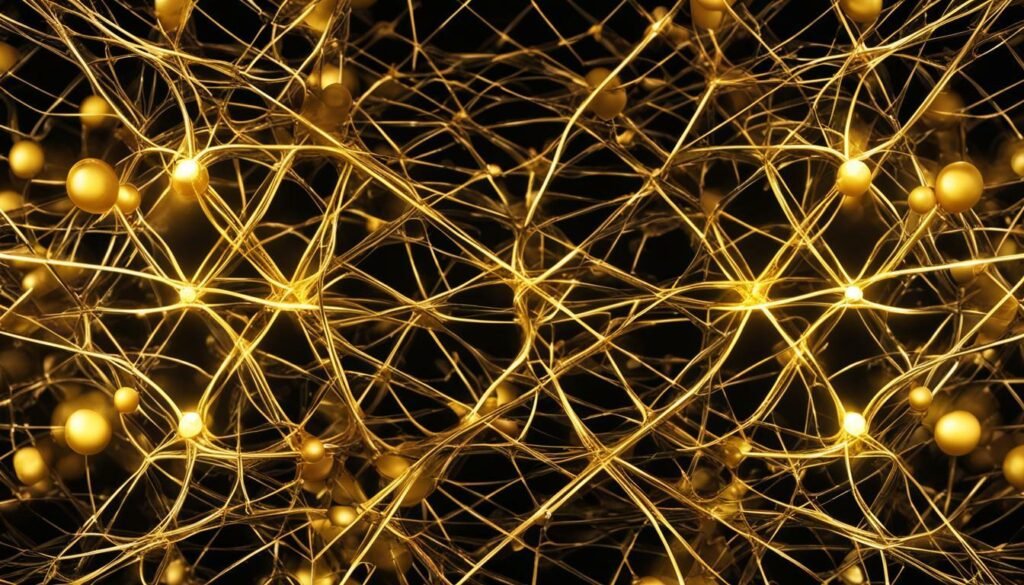Key Takeaways
🧪 Valence electrons are the outermost electrons in an atom and determine an element’s chemical behavior.
🥇 Gold has one valence electron located in its 6s orbital, influencing its unique properties such as resistance to tarnish and high conductivity.
🔍 Gold’s electron configuration is 1s2 2s2 2p6 3s2 3p6 3d10 4s2 4p6 4d10 4f14 5s2 5p6 5d10 6s1, revealing its atomic structure.
⚡ Gold’s lone valence electron plays a fundamental role in its ability to conduct electricity efficiently, making it valuable in electronics.
📿 The stability of gold, stemming from its valence electron, ensures its longevity in jewelry as it doesn’t tarnish easily.
Welcome to the intriguing world of valence electrons, where we delve deep into the atomic structure of gold to uncover its secrets. In this article, we will explore the number of valence electrons present in gold and unravel the significance of these electrons in determining the unique properties of this precious element.
Table of Contents
But first, let’s understand what valence electrons are. Valence electrons are the outermost electrons in an atom’s electron configuration. They play a fundamental role in an element’s chemical behavior and its ability to form chemical bonds with other elements.
Now, let’s take a closer look at gold. A dense, soft, and malleable metal, gold has fascinated us for centuries. Its use extends beyond jewelry and finds value in various industries.
To determine the number of valence electrons in gold, we need to examine its electron configuration. Electron configuration refers to the arrangement of electrons in an atom’s energy levels and orbitals. By analyzing gold’s electron configuration, we can identify its valence electrons.
Gold’s electron configuration may appear complex, but with a step-by-step breakdown, we can make sense of it all. Through the identification of the last energy shell where the valence electron resides, we gain a deeper understanding of gold’s atomic structure.
So, how many valence electrons does gold have? Gold possesses one valence electron, which plays a crucial role in its chemical behavior. This lone electron influences gold’s unique properties, such as its resistance to tarnish and excellent conductivity.
Valence electrons are vital for chemical bonding, and gold’s valence electron is no exception. In the following sections, we will explore how valence electrons participate in the formation of chemical bonds, enabling gold to create compounds and interact with other elements.
Understanding the valence electrons of gold goes beyond theoretical knowledge. In practical applications, knowledge of gold’s valence electron empowers scientists and engineers in various fields, from materials science to electronics.
Gold’s valence electron contributes to its remarkable properties. From its lustrous appearance to its density and resistance to corrosion, gold’s unique characteristics are influenced by its valence electron.
As we conclude our exploration, we have unraveled the mystery of gold’s valence electrons. Armed with this knowledge, you can appreciate the significance of gold’s valence electron and better comprehend the behavior of this precious element.
What are Valence Electrons?
Valence electrons are the outermost electrons in an atom’s electron configuration. They play a crucial role in determining an element’s unique chemical properties and its ability to form chemical bonds with other elements. In the case of gold, understanding its valence electrons is key to unlocking the secrets of this precious element.

The valence electrons of an element are determined by the total number of electrons in the last orbit or shell. For gold, the electron configuration is 1s2 2s2 2p6 3s2 3p6 3d10 4s2 4p6 4d10 4f14 5s2 5p6 5d10 6s1. From this configuration, we can identify that gold has one valence electron located in the last energy shell, specifically the 6s orbital.
These valence electrons of gold are significant because they contribute to the element’s unique properties. Gold’s one valence electron plays a crucial role in its chemical behavior, influencing its exceptional resistance to tarnish and excellent conductivity. Additionally, valence electrons are essential for chemical bonding, enabling gold to create compounds and interact with other elements in various scientific and technological applications.

| Element | Valence Electrons |
|---|---|
| Gold | 1 |
An Overview of Gold
Welcome to the fascinating world of gold, a dense, soft, and malleable element that has captivated humans for centuries. From dazzling jewelry to advanced technology, gold has found its place in various industries, proving its worth both aesthetically and functionally.
Gold’s distinct characteristics make it stand out among other elements. It possesses a lustrous appearance that catches the eye and creates a sense of luxury. Its high density, almost twice that of lead, adds to its value and gives it a substantial feel. Furthermore, gold’s resistance to corrosion makes it a trusted material for long-lasting jewelry and electronic components.
But gold is not just a symbol of wealth and beauty. Its applications go beyond adornment. Gold’s excellent conductivity makes it a vital component in technology, enabling the efficient flow of electricity in circuits. Not only that, but gold also plays a significant role in various fields such as medicine and dentistry, where its biocompatibility and durability make it an ideal material for implants and dental restorations.

| Gold’s Properties | Applications |
|---|---|
| High density | Jewelry |
| Lustrous appearance | Electronics |
| Resistance to corrosion | Medicine and dentistry |
| Excellent conductivity | Technology |
As we delve deeper into gold’s valence electrons, it’s important to have a solid understanding of this remarkable element. Now that you have a brief overview of gold and its properties, get ready to discover the secrets of its atomic structure and how valence electrons play a crucial role in its behavior.
Understanding Electron Configuration
Now that we have a general overview of gold, let’s dive deeper into its electron configuration. Electron configuration refers to the arrangement of electrons in an atom’s energy levels and orbitals. It helps us understand the organization of electrons around the nucleus and provides insight into an element’s chemical behavior.
To determine the electron configuration of gold, we examine the order in which electrons fill different energy levels and orbitals. For gold, the electron configuration is 1s2 2s2 2p6 3s2 3p6 3d10 4s2 4p6 4d10 4f14 5s2 5p6 5d10 6s1. The last energy level, in this case, the 6s orbital, contains the valence electron.
Here is a breakdown of gold’s electron configuration:
| Energy Level | Orbitals | Number of Electrons |
|---|---|---|
| 1 | 1s | 2 |
| 2 | 2s, 2p | 8 |
| 3 | 3s, 3p, 3d | 18 |
| 4 | 4s, 4p, 4d | 32 |
| 5 | 5s, 5p, 5d | 50 |
| 6 (Valence Level) | 6s | 1 |

The valence electron of gold, located in the 6s orbital, is the outermost electron and plays a crucial role in defining the element’s chemical properties. Understanding the electron configuration of gold helps us comprehend why it exhibits certain behaviors and how it interacts with other elements to form compounds.
Deconstructing Gold’s Electron Configuration
Now that we have a general understanding of what valence electrons are and a quick overview of gold, let’s dive deeper into the electron configuration of this fascinating element. Gold’s electron configuration is a complex series of orbital designations that can seem overwhelming at first. However, by breaking it down step by step, we can make sense of it all and identify the valence electron in gold’s atomic structure.
Gold’s electron configuration is as follows: 1s2 2s2 2p6 3s2 3p6 3d10 4s2 4p6 4d10 4f14 5s2 5p6 5d10 6s1. Breaking it down further, we can see that gold has five energy shells. The first shell contains two electrons, the second shell contains eight electrons, the third shell contains 18 electrons, the fourth shell contains 32 electrons, and the fifth shell contains 18 electrons.
The valence electrons of an element are determined by the total number of electrons in the last orbit or shell. In the case of gold, the last energy shell is the sixth shell, also known as the 6s orbital. The electron in this orbital is considered the valence electron of gold. Therefore, gold has one valence electron.
The valence electrons of gold play a crucial role in determining its chemical behavior and unique properties. They are responsible for gold’s resistance to tarnish and its excellent conductivity. Understanding the electron configuration and valence electrons of gold provides us with valuable insights into its behavior in various fields, from materials science to electronics.

The Electron Configurations of Gold
Now that we have a general understanding of gold’s properties and the significance of valence electrons, let’s dive deeper into the electron configurations of gold. Gold’s electron configuration is a complex series of orbitals and energy levels, but by breaking it down step by step, we can gain a better understanding of its atomic structure.
In gold, the electron configuration can be represented as 1s2 2s2 2p6 3s2 3p6 3d10 4s2 4p6 4d10 4f14 5s2 5p6 5d10 6s1. This configuration tells us that in the last energy shell, which is the 6th shell, gold has only one valence electron.
The valence electron, located in the 6s orbital, is the one responsible for gold’s unique chemical properties. It plays a crucial role in bonding with other elements, enabling gold to form compounds and interact with its environment. This lone valence electron contributes to the lustrous appearance, density, and resistance to corrosion that gold is renowned for.
Gold’s electron configuration can be compared to a beautiful symphony, with each orbital and energy level playing its part in the intricate atomic structure. However, it is the valence electron, like the conductor of the orchestra, that leads the chemical behavior of gold and creates its mesmerizing properties.
To summarize, gold’s electron configuration is a complex arrangement of orbitals and energy levels, with the valence electron residing in the 6s orbital. This valence electron is responsible for gold’s unique properties and its ability to participate in chemical bonding. By understanding the electron configurations of gold, we can gain a deeper appreciation for this precious element and its role in various fields.
| Energy Level/Shell | Orbital | No. of Electrons |
|---|---|---|
| 1 | 1s | 2 |
| 2 | 2s | 2 |
| 2 | 2p | 6 |
| 3 | 3s | 2 |
| 3 | 3p | 6 |
| 3 | 3d | 10 |
| 4 | 4s | 2 |
| 4 | 4p | 6 |
| 4 | 4d | 10 |
| 4 | 4f | 14 |
| 5 | 5s | 2 |
| 5 | 5p | 6 |
| 5 | 5d | 10 |
| 6 | 6s | 1 (Valence Electron) |
Gold’s Valence Electron: The Key to its Properties
Now that we know that gold has one valence electron, let’s explore the significance of this lone electron. Gold’s valence electron plays a crucial role in its chemical behavior, influencing its unique properties such as its resistance to tarnish and excellent conductivity. It is this valence electron that gives gold its distinct characteristics, making it one of the most sought-after elements in various industries.
With a single valence electron in its outermost energy shell, gold exhibits exceptional stability and low reactivity. This stability is one of the reasons why gold is highly valued in jewelry, as it does not easily react with air or water, ensuring that its beauty and shine remain intact for years.
The valence electron in gold also contributes to its exceptional electrical conductivity. Valence electrons are responsible for the flow of electric current in metals, and gold’s single valence electron allows it to effortlessly conduct electricity, making it ideal for use in electronics and electrical components.
Gold’s valence electron is like a key that unlocks its remarkable properties. It is this lone electron that defines gold’s behavior and makes it stand out among other elements. Understanding the importance of gold’s valence electron opens doors to a world of possibilities, where this precious metal can be harnessed in innovative ways for various applications.
| Property | Description |
|---|---|
| Resistance to Tarnish | Gold’s valence electron prevents the formation of compounds that tarnish, allowing it to maintain its lustrous appearance over time. |
| High Electrical Conductivity | The valence electron in gold facilitates the efficient movement of electrons, making it an excellent conductor of electricity. |
| Density | Gold is a dense metal due to the presence of its valence electron and its tightly-packed atomic structure. |
| Corrosion Resistance | Thanks to its valence electron, gold is highly resistant to corrosion, making it ideal for use in marine environments and medical applications. |
Gold’s valence electron is truly a remarkable feature of this precious metal. It not only contributes to its unique properties but also opens up a world of possibilities for its practical applications. Whether it’s in jewelry, electronics, or various industries, the valence electron in gold holds the key to its exceptional behavior and desirability.

Valence Electrons and Chemical Bonding
Valence electrons play a vital role in chemical bonding, and gold’s valence electron is no exception. With its single valence electron, gold possesses unique properties that make it highly sought after in various industries. Let’s explore the significance of valence electrons in gold’s chemical bonding and how it contributes to its exceptional characteristics.
Gold’s valence electron resides in the 6th energy shell, specifically in the 6s orbital. This lone electron is easily shared or transferred when gold interacts with other elements, facilitating the formation of chemical bonds. Due to its low reactivity, gold tends to form bonds with elements that have similar electronegativities or those that can enhance its stability.
When gold forms chemical bonds, it can create a variety of compounds with distinctive properties. For example, gold can form compounds with halogens, such as chlorine, resulting in colorful gold salts. The valence electron’s participation in these chemical reactions allows gold to exhibit diverse chemical behaviors and create compounds with varying characteristics.
| Element | Bonding with Gold | Resulting Compound |
|---|---|---|
| Chlorine | Gold + Chlorine | Gold Chloride (AuCl3) |
| Sulfur | Gold + Sulfur | Gold Sulfide (Au2S3) |
| Carbon | Gold + Carbon | Gold Carbide (AuC2) |
Understanding the role of valence electrons in gold’s chemical bonding is crucial for scientists and engineers in various fields. This knowledge allows them to design and manipulate gold compounds for applications in materials science, electronics, and even medicine. By harnessing the unique properties of gold’s valence electron, researchers can develop innovative technologies and materials with improved performance and functionality.

In conclusion, gold’s valence electron holds immense significance in determining the element’s properties and its ability to form chemical bonds. From its stability and resistance to tarnish to its involvement in compound formation, the valence electron of gold is a building block for its remarkable characteristics. By delving into the world of valence electrons and chemical bonding, we gain a deeper understanding of gold’s behavior, unlocking its potential for various applications in science and industry.
Applications of Gold’s Valence Electron Knowledge
Now that you have a solid understanding of gold’s valence electrons and their role in its atomic structure, let’s explore the practical applications of this knowledge. Scientists and engineers in various fields utilize the understanding of gold’s valence electron to drive innovation and create groundbreaking technologies.
One significant application lies in materials science. Gold’s unique properties, influenced by its valence electron, make it an ideal choice for many applications. Its excellent conductivity and resistance to tarnish make it a valuable component in electronics, such as connectors and electroplating. Additionally, gold’s malleability and corrosion resistance find applications in the development of specialty coatings and films.
In the field of medicine, gold’s valence electron plays a crucial role in the advancement of diagnostic tools and treatments. Gold nanoparticles, engineered to have specific sizes and shapes, are utilized in biomedical imaging techniques, such as contrast agents for enhanced visualization of tissues and tumors. Moreover, gold’s biocompatibility and low toxicity make it an attractive candidate for drug delivery systems.
| Field | Application |
|---|---|
| Materials Science | Electronics, specialty coatings |
| Medicine | Biomedical imaging, drug delivery |
| Chemistry | Catalysis |
In the realm of chemistry, gold’s valence electron plays a vital role in catalysis. Gold nanoparticles are widely used as catalysts in various chemical reactions due to their unique electronic and geometric properties. These catalysts are employed in organic synthesis, environmental remediation, and the production of fine chemicals.
As we continue to unlock the secrets of gold’s valence electrons, we gain a deeper understanding of this precious element’s behavior and its potential applications in a wide range of industries. From materials science and medicine to chemistry and beyond, the knowledge of gold’s valence electron opens doors to new discoveries and advancements that shape our world.

Exploring Gold’s Unique Properties
Gold is a remarkable element with a wide range of unique properties that make it highly valuable and sought after. Its lustrous appearance, density, and resistance to corrosion are just a few of the characteristics that set gold apart from other metals.
One of the most striking properties of gold is its distinct golden color. Unlike most other metals, which are silver or gray in their pure form, gold has a beautiful and unmistakable hue that has captivated humans for centuries. Its vibrant color has made it a symbol of wealth and luxury.
Another property that makes gold stand out is its density. Gold is one of the densest elements, meaning it has a high mass for its volume. This density gives gold its characteristic heaviness and makes it feel substantial in the hand. In fact, a small amount of gold can weigh a significant amount compared to other materials.
The exceptional resistance of gold to corrosion is yet another notable property. Unlike many metals that tarnish or oxidize over time, gold remains virtually unaffected by air, moisture, and most acids. This resistance to corrosion is one reason why gold has been used for jewelry and decorative purposes throughout history.
Gold’s Unique Properties in Summary:
- Distinct golden color
- High density
- Resistance to corrosion
Gold’s unique properties have made it not only a highly prized precious metal but also an essential element in various industries. Its beauty, density, and resistance to corrosion make it invaluable in jewelry, electronics, and even medical applications. The properties of gold are a testament to its enduring allure and its enduring value.
| Property | Description |
|---|---|
| Color | Distinctive golden hue |
| Density | One of the densest elements |
| Corrosion Resistance | Highly resistant to tarnish and oxidation |

Gold’s Valence Electron: A Building Block for Compounds
Gold’s unique properties and its ability to form compounds can be attributed to its valence electron, which plays a crucial role in chemical bonding. With one valence electron, gold exhibits a range of chemical behaviors that make it a highly versatile element in various applications.
The electron configuration of gold, 1s2 2s2 2p6 3s2 3p6 3d10 4s2 4p6 4d10 4f14 5s2 5p6 5d10 6s1, reveals that the valence electron is located in the 6s orbital. This lone electron in the outermost energy shell makes gold susceptible to interaction with other elements, allowing it to form compounds through chemical bonding.
Gold compounds, also known as gold complexes, can take on various forms depending on the elements it bonds with. For example, when gold bonds with sulfur, it forms gold sulfide (Au2S), a compound commonly found in mineral deposits. Gold compounds can also form coordination complexes, where the valence electron interacts with molecules or ions to create stable structures.
The ability of gold to form compounds is of great importance in many fields. In the medical industry, gold compounds are utilized in cancer treatments and diagnostic tools. In electronics, gold is employed in the production of conductive materials and soldering. Additionally, gold compounds have applications in catalysis, where they are used as catalysts in chemical reactions.

| Gold Compound | Chemical Formula | Application |
|---|---|---|
| Gold sulfide | Au2S | Mineral deposits |
| Gold chloride | AuCl3 | Medicine, photography |
| Gold nanoparticles | AuNPs | Medicine, electronics |
In conclusion, gold’s valence electron serves as a building block for compounds, enabling gold to participate in chemical reactions and form stable structures. This unique characteristic of gold opens up a world of possibilities in various industries, from medicine to electronics. By harnessing the power of gold’s valence electron, scientists and engineers continue to unlock new applications and advancements.
Conclusion
Congratulations! You have successfully unlocked the mystery of gold’s valence electrons and gained a deeper understanding of this precious element’s atomic structure. By exploring the fascinating world of valence electrons, we have unraveled the secrets behind gold’s unique chemical properties and its ability to form compounds.
Through the analysis of gold’s electron configuration, we discovered that gold has one valence electron located in the last energy shell. This lone electron plays a crucial role in determining the properties that make gold so highly prized, such as its exceptional conductivity and resistance to tarnish.
Furthermore, understanding gold’s valence electron allows scientists and engineers to harness its potential in various practical applications, ranging from materials science to electronics. With this knowledge, they can manipulate and utilize gold’s chemical behavior to develop innovative technologies and advancements.
In conclusion, the valence electron of gold is the key to unlocking its remarkable properties and potential.
So next time you admire a piece of gold jewelry or marvel at the technological marvels made possible by gold, remember that it’s all thanks to that one valence electron that sets gold apart.
FAQ about How Many Valence Electrons Does Gold Have
Q: What are valence electrons?
A: Valence electrons are the outermost electrons in an atom’s electron configuration. They determine the chemical properties and bonding behavior of an element.
Q: How many valence electrons does gold have?
A: Gold has one valence electron.
Q: What is the electron configuration of gold?
A: The electron configuration of gold is 1s2 2s2 2p6 3s2 3p6 3d10 4s2 4p6 4d10 4f14 5s2 5p6 5d10 6s1.
Q: What role do valence electrons play in determining the properties of gold?
A: Valence electrons play a crucial role in determining the properties of gold, such as its resistance to tarnish and excellent conductivity.
Q: How do valence electrons participate in chemical bonding?
A: Valence electrons participate in the formation of chemical bonds, allowing gold to create compounds and interact with other elements.
Q: What are some practical applications of knowledge about gold’s valence electron?
A: Knowledge about gold’s valence electron is useful in fields such as materials science and electronics.
Q: What are some of the unique properties of gold?
A: Gold’s unique properties include its lustrous appearance, density, and resistance to corrosion.
Q: How does gold’s valence electron contribute to the formation of compounds?
A: Gold’s valence electron interacts with other elements, allowing for the formation of different gold compounds.
Source Links
- https://valenceelectrons.com/valence-electrons-for-gold/
- https://materials.gelsonluz.com/2019/08/valence-electrons-in-gold-au-facts.html?m=1
- https://homework.study.com/explanation/write-the-electron-configurations-for-the-following-atoms-and-indicate-how-many-valence-electrons-are-present-a-silicon-b-selenium-c-copper-d-iron-e-cesium-f-platinum-g-lead-h-gold-i-bismuth.html








